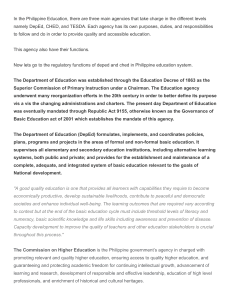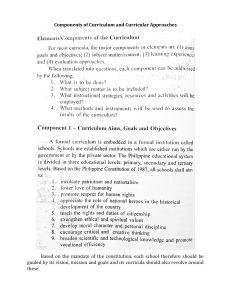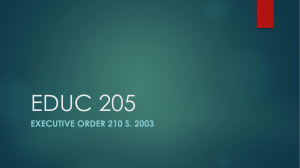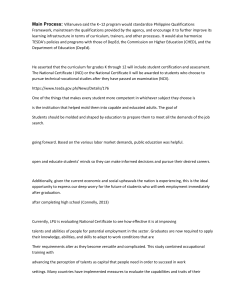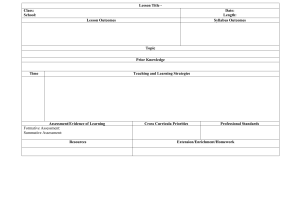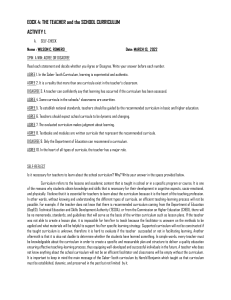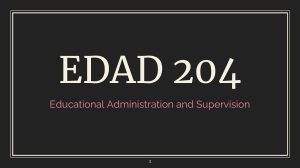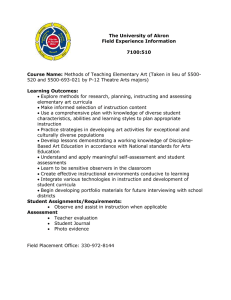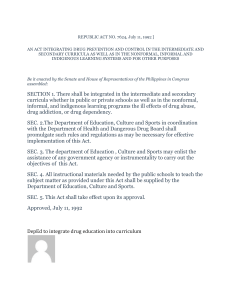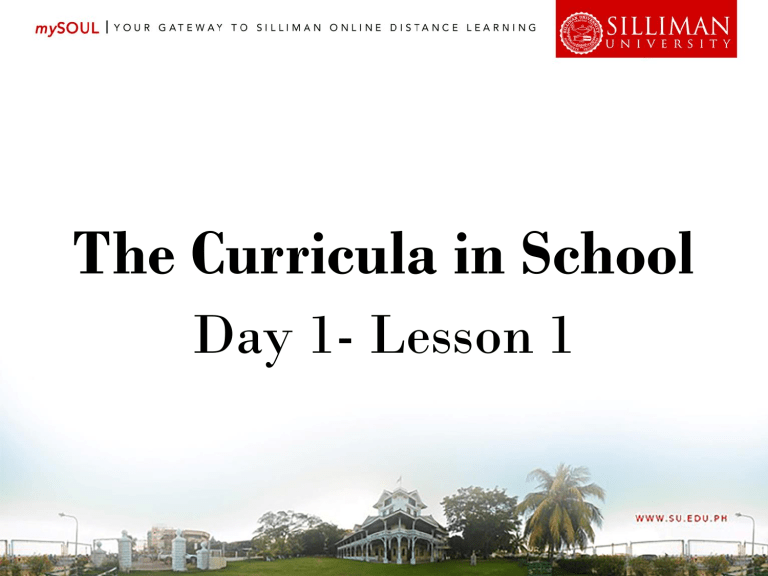
The Curricula in School Day 1- Lesson 1 Desired Learning Outcome 1. 2. Discuss the different curricula that exist in the school Analyze the significance of curriculum and curriculum development in the teacher’s classroom Curriculum • organized knowledge taught in schools • includes several modes of thoughts or experiences • Formal, non-formal, or informal education do not exist without a curriculum. • Classroom will be empty with no curriculum. • Teachers will have nothing to do if there is no curriculum. • Curriculum is at the heart of the teaching profession. • Every teacher is guided by some sort of curriculum in the classroom and in schools. • Philippine Educational System Three educational levels • 1. Basic Education • 2. Technical, Vocational Education • 3. Higher Education • • • • • • Basic Education Kindergarten Grades 1 to 6 for elementary Grades 7 to 10 for secondary Grades 11 to 12 for senior high school Each of the levels has its specific recommended curriculum K to 12 Enhanced Curriculum of 2013 of the Department of Education • • • • Technical, Vocational Education Post secondary technical, vocational education and training Technical Education and Skills Development Authority (TESDA) For the TechVoc track in SHS of DepEd, Close coordination between DepEd & TESDA • • Higher Education Baccalaureate or Bachelor Degrees and the Graduate Degrees (Masters and Doctorate) under the regulation of the Commission on Higher Education (CHED) Types of Curricula 1. Recommended Curriculum 2. Written Curriculum 3. Taught Curriculum 4. Supported Curriculum 5. Assessed Curriculum 6. Learned Curriculum 7. Hidden/Implicit Curriculum • • • • • Recommended Curriculum Almost all curricula found in our schools are recommended. DepEd, TESDA, CHED oversee and regulate Philippine education. Recommendations come in the form of memoranda, policies, standards, and guidelines. Other professional organizations or international bodies like UNESCO also recommend curricula in schools. United Nations educational, Scientific and Cultural Organization (UNESCO) • • Written Curriculum documents based on the recommended curriculum course study, syllabi, modules, books, instructional guides, teachers’ lesson plan • • • Taught Curriculum The teachers and the learners will put life to the written curriculum. The skill of the teacher to facilitate learning based on the written curriculum with the aid of instructional materials depends on the teaching of the teacher and the learning style of the teachers • • • • • Supported Curriculum support materials that the teachers need print material, books, charts, posters, worksheets, non-print material, PPP, movie clips, slides, models, realias, and other electronic illustrations facilities where learning occur: playground, science laboratories, audio-visual rooms, zoo, museum, market, plaza places where authentic learning through direct experiences occur • • • Assessed Curriculum progress of learning (assessment for learning) how much has been learned or mastered (assessment of learning) self-assessment (assessment as learning) • • Learned Curriculum cognitive, affective and psychomotor outcomes demonstrate higher order thinking skills, critical thinking skills, lifelong skills • • • Hidden/Implicit Curriculum not deliberately planned has great impact on the behavior of the learners Factors that create hidden curriculum: peer influence, school environment, media, parental pressures, societal changes, cultural practices, natural calamities Task # 1: The Curricula in School Is it necessary for teachers to learn about school curriculum? Why or Why not? (Answer in 300 to 500 words essay) Reference Bilbao, et al (2020). The Teacher and the School Curriculum. Quezon City: Lorimar Publishing, Inc.
